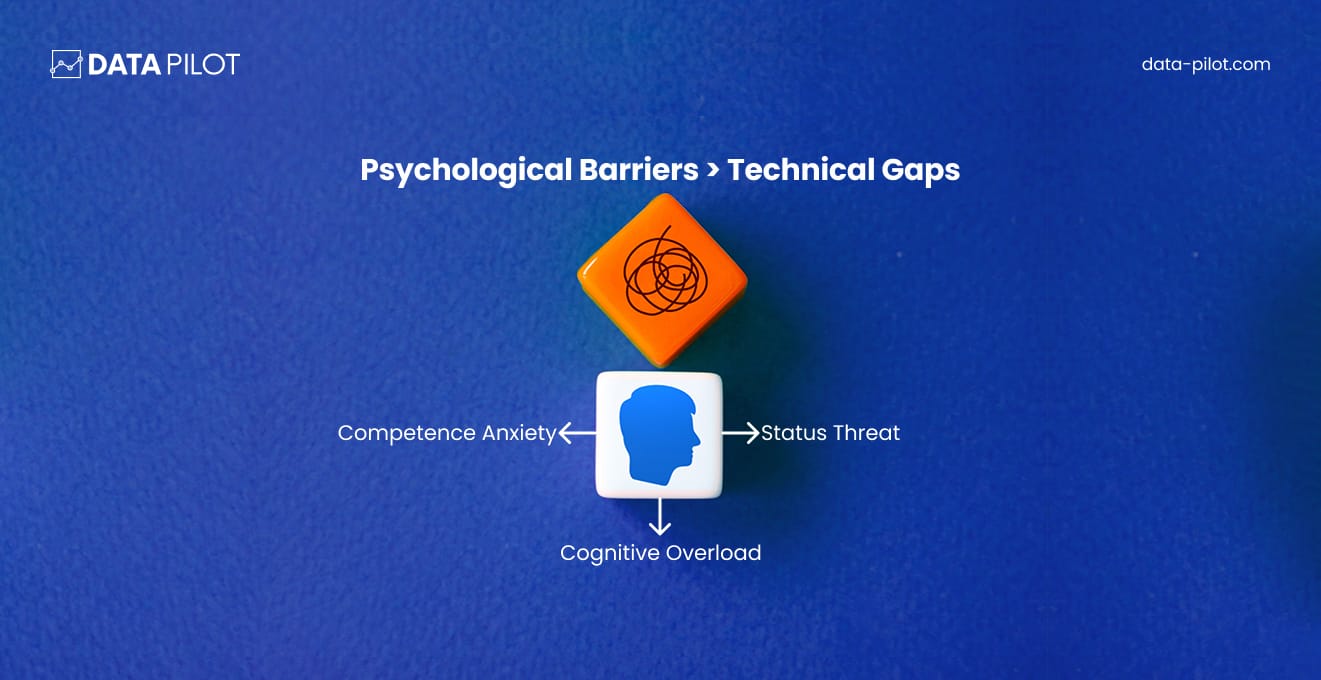
Did you know that 73.5% of respondents at data-leading companies worldwide reported that their decision-making processes are always data-driven? Yet, despite the current focus on AI in helping process and make sense of data, only 60% of organizations have adopted AI and big data in their businesses together. What’s even more shocking is that almost all companies invest in AI, but just 1% believe they are reaping optimal returns or their investments have matured.
According to McKinsey, the biggest obstacle to scaling is change management and how leaders and executives are incapable of steering things as quickly as needed. In McKinsey’s research, organizations highlighted that the greatest challenge to becoming data-driven and AI-focused was a function of culture, people, process change, and organizational alignment—and had little to do with technology limitations.
Companies succeeding in building truly data-driven cultures aren’t just breaking data silos, hiring young energetic people, or using the latest technology—they’re revolutionizing how leaders think, act, and inspire their teams to embrace data at every level.
The Hidden Crisis: Why Data Initiatives Keep Failing

Picture this.
Your company invests millions in a state-of-the-art analytics platform. You hire top-tier data scientists, create clear, beautiful dashboards, and set up everything you need to become data-driven. However, six months later, your executives are relying on their guts and instincts to make decisions, and your teams are frustrated because “the data is not telling the whole story.” Or perhaps they aren’t using the data appropriately.
If you’re in this situation, you’re not alone. Data-driven decision-making has developed significantly throughout the 21st century, with technological advancements and an ever-changing business landscape. From that, stems data-driven leadership, which is a management approach where decisions are informed by data analysis and insights rather than relying solely on intuition or experience. Yet despite this evolution, most organizations are stuck in what we call the “data paradox”, where they have more data than they ever previously had, but struggle to use it effectively for strategic decisions.
This mainly stems from leadership behaviors that unintentionally sabotage data adoption.
The Leadership Framework That Actually Works
Forget everything you’ve been told about data-driven leadership. The companies that are genuinely transforming their cultures follow a radically different playbook – one that puts human psychology and behavioral change at the center of data strategy.
There are 3 components of a leadership framework that guarantees results with data and AI once they’re employed across the entire organization.
1. Transparency and Clarity Over Siloed Decisions
In the traditional approach to leadership, executives preach the importance of data while making decisions behind closed doors. On the contrary, in a data-driven approach, leaders make their data-driven decision process transparent and visible.
At Walmart, executives don’t just use data. They demonstrate exactly how data influenced their decisions. Walmart’s data-driven approach is evident in its personalized customer shopping experience, where data analytics guides merchandise stocking and display decisions. When leaders show their work, teams follow suit.
So, in your next leadership meeting, don’t just present your decision. Walk all the stakeholders through the data that led to it. Show the questions you asked, the analyses you conducted, and the trade-offs you considered. This will ensure everyone is on the same page and can give feedback where required, creating a cohesive working environment.
 2. Failure as Fuel Mentality
2. Failure as Fuel Mentality
Most leaders expect their data to provide certainty. But the reality is that data reduces uncertainty and doesn’t fully eliminate it. For example, a dashboard might show a sudden drop in website traffic and suggest a performance issue, but further analysis could reveal that it was caused by a change in tracking settings rather than an actual decline.
Relying solely on the numbers without context or critical thinking could lead to inaccurate conclusions. Most business leaders either take evidence presented as gospel or dismiss it altogether. Both approaches are misguided. The key is creating a culture where data informs decisions, but leaders must also acknowledge the limitations of the data and continuously refine their approach.
Revolutionary leaders embrace what we call “intelligent failure” which entails using data to make the best possible decisions based on their experience and judgment. Then, learning rapidly from outcomes, even if they have failed, to improve future decision-making processes. Like them, you must embrace failure as fuel and adapt instead of dwelling on it.
3. The Democratization Imperative
Stop hoarding data insights within the C-suite. Revolutionary leaders understand that data democratization means making data more accessible. Companies should invest in tools and platforms that enable technical personnel to access and interpret this data.
For example, when a customer support team can access churn metrics and see how unresolved tickets impact retention, they’re more likely to prioritize response times and escalate issues effectively. As a leader, you must give every team member access to relevant data and train them to use it. When people can see how their work contributes to broader outcomes, engagement and performance skyrockets. But how do you get executives to agree to adopt this approach?
How to Get Executive Buy-In for Data Initiatives
Stop trying to sell executives on data transformation. They may not have time to look at all the dashboards. They care about the results. Here’s how to speak their language:
Start with pain, not potential. Walk into that boardroom with three numbers:
- How much did the last major wrong decision cost
- How long did it take to course-correct
- What opportunity did you miss while figuring it out?
Make it personal and use decisions they were involved in.
Pick one decision that matters right now
Don’t propose a company-wide data overhaul. Find one decision your CEO makes regularly – pricing, inventory, hiring, market expansion – and show how data can make it 10% better. Research shows companies that embrace data-driven decision-making can see an impressive revenue boost of ~16%, but executives need to see it work in their specific context first.
Show them what good looks like in their industry
Generic case studies about Amazon don’t work. Find a competitor or industry peer who’s winning with data and break down exactly what they’re doing differently. Make it competitive; nobody wants to be left behind.
Make it ridiculously easy to say yes
Ask for 30 days and a small team to tackle one specific problem. Promise concrete results or you’ll stop. Remove every barrier to getting started. Want budget approval? Come with exact costs and clear ROI projections.
Need resources? Identify exactly who or what and for how long.
Create visible wins that spread organically
Once you get that first yes, make the success impossible to ignore. When other executives see their peers getting better results, they’ll come asking how to do the same thing in their area. This is how real culture change happens—through peer influence, not top-down mandates.
Let’s dive deeper into this.
The Psychology of Data Adoption: Why Technical Training Isn’t Enough
As established, people don’t resist data – they resist change. Another core reason for data initiative failure is because they focus on technical skills, instead of addressing the psychological barriers to adoption.
There are 3 psychological barriers to adopting data in your organization and how you can overcome them:

- Competence Anxiety: This comes in the form of “What if I make the wrong decision even with data?”. The best way to overcome this for yourself and for your employees is to create safe spaces for experimentation and learning.
- Status Threat: This is when you may ask yourself: “If decisions are data-driven, what’s my value as an experienced leader?”. In this case, treat your data as a tool to enhance your human judgment instead of letting it replace you.
- Cognitive Overload: We all know that the more the data, the more informed the decisions. But what if there’s too much data and you can’t seem to figure out what’s important?
This is a common situation known as cognitive overload. The solution for this is simple: get the right data visualization tools like Power BI or Tableau to help you transform complex datasets into visually intuitive graphs, charts, and dashboards.
The Future-Proof Leadership Playbook
The landscape is changing rapidly. The next generation of leaders will equip themselves with the right skills:
- Data Storytelling: The ability to translate complex analyses into compelling narratives that drive action.
- Ethical Data Leadership: The future holds emphasis on ethical data governance, with leaders focusing on transparent and ethical data practices, ensuring compliance with data regulations.
- Adaptive Intelligence: The skill to combine data insights with contextual understanding and human judgment.
Beyond 2025, successful leaders will need to master what we call “augmented decision making”, a skill where you seamlessly blend human intuition with data insights to make faster, better decisions in an increasingly complex world. The organizations that will thrive will be those where leaders model data-driven behaviors, create psychological safety for data experimentation, and continuously evolve their decision-making processes based on new insights.
Also Read [ 5 Best Practices for Building and Leading Successful Data Teams ]
The Bottom Line
Data doesn’t drive culture—leaders do. The most sophisticated analytics platform in the world won’t create a data-driven culture if leaders don’t model the behaviors they want to see. The companies winning in the data revolution aren’t necessarily the ones with the best technology. They’re the ones with leaders who understand that building a data-driven culture is fundamentally about human behavior, not technical capability.
Whether it’s identifying potential risks early on, improving resource utilization, or making informed decisions regarding production, timelines, and budgets, data can play a pivotal role in the success of projects. But only if leaders create conditions for success. The revolution starts with you. The question isn’t whether your organization needs to become more data-driven—it’s whether you’re ready to lead the transformation.
Your next step should be to choose one decision you’ll make this week using a data-driven approach. Make the process visible to your team, share what you learned, and then watch the culture begin to shift, one decision at a time. The future belongs to leaders who don’t just have data, but they use it to inspire, decide, and win.
How Can Data Pilot Help?
Data Pilot empowers organizations to build a data-driven culture by offering end-to-end services across data engineering, analytics, AI solutions, and data science. From setting up modern data platforms and cloud data warehouses to creating automated reporting dashboards and self-serve analytics tools, we make data accessible and actionable. With scalable solutions tailored to each organization, we enable faster, smarter, and more confident decision-making at every level. Ready to transform your organization’s data culture?
Fill out the form below and let’s connect.